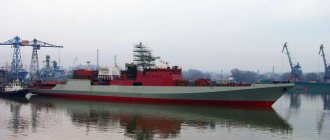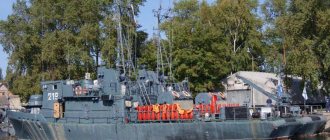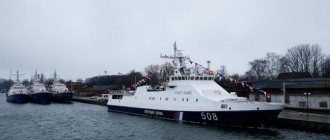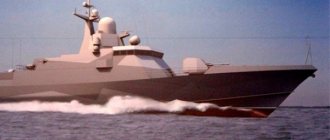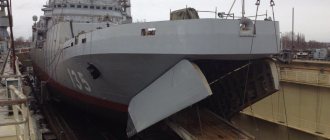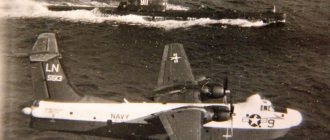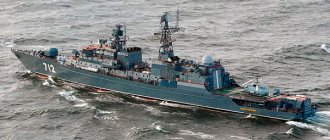"Vasily Bykov", the lead ship of Project 22160, sets out on its first long voyage. The protection of maritime borders has always been carried out by ships of relatively small size. Their capabilities were usually small, but this was enough to combat ordinary violators. Today the situation has changed somewhat - now security functions may be in demand not only near the native shores, but also at a great distance from them. The Project 22160 patrol ships, developed by JSC Northern Design Bureau at the end of the 2000s, are designed to solve precisely such problems. Two of them have already begun service, and four more will appear in the fleet in the coming years.
History of creation
Since approximately 2003, off the coast of Somalia, mainly in the Gulf of Aden region formed by the Arabian Peninsula and the African continent, many merchant ships have been attacked by local pirates. Over time, this local problem became so serious that it required discussion at the United Nations level. Several Russian ships also became victims of hijacking and robbery.
Several different countries launched the fight against sea robbers by sending warships to the Gulf of Aden. Russia also took part in these events, and quite successfully, but from the very beginning it became clear that chasing small pirate boats with missile cruisers and large anti-submarine ships was clearly an unjustified waste of effort and resources.
The Russian fleet also had small ships at its disposal, but they either did not have sufficient seaworthiness, or their autonomy did not allow them to carry out long-term patrols at a considerable distance from the base.
The large anti-submarine ship "Severomorsk" patrols the Gulf of Aden.
All this did not allow us to achieve the necessary efficiency. The question arose about creating a new type of ship, which had the following tasks:
- Detection and detention of poachers and smugglers;
- Carrying out search and rescue operations;
- Protection of various water areas and naval bases;
- Escorting vessels during transitions.
All this is reminiscent of the functions of ordinary “watchdogs” that are used by border guards. It was for them that the Project 22160 patrol ships were initially created at the Severnoye design bureau in St. Petersburg. It must be taken into account, however, that the protection of the state borders of Russia is the responsibility of the Federal Security Service, whose powers are simply not responsible for long-distance sea voyages, including to the shores of Somalia. included - only the Navy can carry out operations in such zones.
There is a very significant, even conceptual difference between those ships that are usually built for the Navy and “patrol ships”. The fact is that solving ordinary “borderline” tasks does not require equipping the vessel with complex and expensive weapons systems. Military sailors, on the contrary, require serious firepower, and even “in all directions.” Placing missiles, anti-submarine weapons and cruise missile launchers on a patrol ship would turn the patrol ship into a full-fledged corvette.
Such a rework was technically possible, but it would have sharply increased the cost of the project and, in addition, threatened to reduce the battery life. Both directly contradicted the original plan. To solve this problem, PCB designers decided to apply the so-called modular approach.
The initial stage of construction of the ship "Vasily Bykov" at the Zelenodolsk plant
In practice, this means that the “basic” corvette of Project 22160 is equipped with rather modest weapons, which correspond to the tasks of conventional patrolling. At the same time, however, it is always possible to install on it certain weapon systems, made in the form of a standard module. Such re-equipment is carried out literally “on the fly”; the ship does not need to be repaired or undergo any complex operations.
Project 22160 seemed quite promising to the Navy command, and a decision was made to build six patrol ships. Currently, three of them have been fully manufactured - “Vasily Bykov”, “Dmitry Rogachev” and “Pavel Derzhavin”. The first two ships from this list have already been commissioned into the Russian Navy, and the third is being tested.
Service prospects
The new patrol ships will most likely have to fight pirates. Using large ships for this purpose requires unnecessary expenditure of resources.
It is advisable to assign the task of protecting shipping to fast and economical patrol ships.
Seaworthiness allows you to operate in areas of greatest pirate activity (Gulf of Aden). In turn, the DSL is capable of catching up with most pirate boats and ensuring an assault on a captured ship.
"Vasily Bykov", the lead ship of project 22160
The laying of the lead ship of Project 22160, named “Vasily Bykov,” took place in Tatarstan, at the Zelenodolsk shipyard named after Gorky in February 2014. Vasily Ivanovich Bykov is a rear admiral, Hero of the Soviet Union, who received this high rank during his service on torpedo boats during the Great Patriotic War. True, he fought in the Northern Fleet, and the ship, named in memory of this man, was originally intended for service in the Black Sea, based in Novorossiysk or Sevastopol.
Three and a half years later, the almost finished ship was launched and sent along the rivers to Kerch, where the rest of the work on its construction was completed at the plant. Tests were carried out until December 2022, after which the St. Andrew's flag was raised over the Vasily Bykov.
"Vasily Bykov" passes the English Channel.
The open port is clearly visible. In the summer of 2020, this ship made its first voyage, passing through the Mediterranean Sea into the Atlantic Ocean and around Europe. Having covered a considerable distance, the Project 22160 corvette “Vasily Bykov” safely reached St. Petersburg, where it made the “latest news” by taking part in a naval parade.
Protection
Since armor is not provided for Project 22160 corvettes, the defensive role is played by the 5P25 ship complex. This is a multifunctional electronic warfare system capable of protecting a ship from surveillance from space, reconnaissance from sea and land. Includes radar, radio-electronic stations and optical systems, and conducts reconnaissance in the entire wavelength range. Allows you to detect the location of the enemy. The REP complex is capable of hiding a ship from missiles fired at it and redirecting them in the other direction. Provides assistance to weapon systems by issuing advance target designations for air defense systems and gun systems, which can actually save the corvette from attacking weapons. As a result of coordinated operation of the systems, overall survivability increases by 5–7 times.
In addition to electronic protection, the ship is equipped with aerosol camouflage devices. They are launchers that, when missiles approach, fire a special aerosol containing metal shavings into the air, hiding the corvette from view.
Description of design
In their appearance, Project 22160 ships are noticeably different from the previous “patrol ships” that were built in the USSR. This difference is due to the desire of the designers to achieve the maximum reduction in radar signature, while maintaining good seaworthiness. For this purpose, both sides are inclined at a “reverse” angle, and the superstructure is given angular outlines. In addition, a special protective coating is installed on the deck, which also reduces the effective radio wave scattering surface (ERS).
Ship hull and superstructure architecture
The layout of Project 22160 ships is not particularly complex. In the bow there is an AK-176MA artillery turret, and at some distance behind it there is a superstructure. The antenna equipment of the Pozitiv-MK radar station is located on its roof. The radar can detect large targets at a distance of 300 kilometers, and aircraft of the same size as an F-16 fighter at a distance of about 110 kilometers.
At the rear of the superstructure there is a hangar for the Ka-27PS onboard helicopter, the use of which significantly expands the capabilities of the patrol ship. The take-off area for the rotorcraft is located at the stern. Directly below it, inside the hull, there is a compartment for the Project 02800 landing-assault boat. The disembarkation of the landing ship and its reception after completing the mission is carried out through the open stern port.
Ceremony of handing over the ship "Vasily Bykov" to the Black Sea Fleet
Power point
The Project 22160 patrol ship is driven by two fixed-pitch propellers, each of which is connected to a separate unit. Russian diesel engines 16D49 are used as such. The total power of the power plant is 12,000 horsepower.
The lead "Vasily Bykov", which was built very first, was equipped at the shipyard with German MAN engines, the supply of which was then canceled due to sanctions imposed on Russia.
It should be noted that at the design stage it was assumed that the ship would also be equipped with gas turbine booster engines, allowing it to reach maximum speed in the shortest possible time. Therefore, a number of sources even today indicate that Project 22160 warships have a power plant with a capacity of 34,000 horsepower, which, however, is not true.
Armor
In accordance with statements made by representatives of the Navy during the testing period of the Vasily Bykov, this ship had light bulletproof armor. However, the original design did not include the installation of any protection (probably due to the fact that steel sheets increase radar signature). This detail is still not entirely clear. At least the assault boat is definitely armored.
Landing assault boat project 02800
Design
To reduce visibility, ship surfaces must effectively dissipate radar radiation energy. For this purpose, reverse slopes of the sides, optimal height and shape of the superstructure were used. The surfaces in the bow are covered with sheets of composite materials with radio-absorbing properties.
There is no armor for the hull or superstructure.
The aft section provides space to accommodate two standard size (40 ft) interchangeable modules. Depending on the tasks assigned to the ship, modules may contain:
- UVP for cruise or anti-aircraft missiles;
- anti-mine systems;
- medical equipment;
- equipment for underwater work.
The ship has a hangar for a Ka-27, Ka-29 or Ka-31 helicopter. The presence of a helicopter on board does not interfere with the use of UVP, unlike Project 20386 corvettes.
Landing assault boat
An important element of the Project 22160 corvettes is equipping it with a standard landing assault boat (ALB). It is lightly armored and has a speed of up to 40 knots.
In addition to a crew of two people, an inspection team of 10 marines is placed on board. After the receiver-receiver device is triggered, the DSL falls into the water along the slipway within 30 seconds. This operation and the acceptance of the craft on board is performed while the ship is moving.
Tactical and technical elements
| Displacement, t – standard – full | 1300 1800 |
| Dimensions, m | 94×14×3,4 |
| Travel speed, knots – maximum – economic | 30 16 |
| Cruising range, miles | 6000 |
| Autonomy, days. | 60 |
| GEM power, hp | 32000 |
| Crew, people | 80 |
It is characteristic that with a small (1300 t) displacement it is possible to operate in remote areas, for example, in the Mediterranean Sea or the Gulf of Aden. Moreover, refueling and replenishment of supplies is required no more often than for large participants in the trip. Living conditions are better than those of “classmates”.
These comparative advantages were achieved thanks to a small concentration of standard weapons. The freed up space made it possible to increase the fuel supply and the area of habitable premises.
Power plant
The combined power plant includes two 6000 hp diesel engines. (4.5 MW) each and two gas turbine engines with a capacity of 10 thousand hp. (8 MW). Auxiliary systems: diesel generators – 4×300 kW and one (emergency) – 100 kW.
Specifications
| Displacement | 1300 tons standard, 1965 tons full |
| Ship length | 91.3 m |
| Width | 14.5 m |
| Draft | 4.8 m |
| Full speed | 22.5 knots |
| Patrol speed | 16 knots |
| Cruising range | Up to 6,700 miles at 16 knots |
| Autonomy | 60 days |
| Crew size | Up to 80 people |
It should be noted that some sources indicate other values for a number of characteristics, including ship draft, displacement, maximum and economic speed. The given parameters correspond to the data indicated on the website of the Russian Black Sea Fleet. The reduction in speed is due to the refusal to install gas turbine booster engines. Apparently, this decision itself was made due to the need to increase the autonomy period.
The birth of the Project 22160 corvette
The protection of territorial waters and the 200-mile economic zone was the primary function assigned to the new ships. In addition, their tactical tasks also included non-specific functions:
- combating smuggling in territorial waters;
- combating poaching and illegal fishing in the 200-mile economic zone;
- rescue operations at sea;
- security and escort of ships;
- security of port complexes and naval bases.
Initially, the new corvette was created for the needs of the Border Service of the FSB of Russia, but already at the design stage, the Naval leadership discerned in the project the features of the patrol boat of the future. The new ships have a relatively small displacement (1300 tons).
The maximum speed of the corvette should not have been below 30 knots. The designers were somewhat surprised by the cruising range required in the technical specifications.
The ship, designed to patrol coastal waters, was supposed to have an autonomy of up to 60 days and a cruising range of 6 thousand miles.
The patrol ship has a crew of 80 people. As for standard weapons, the designers had to choose between two concepts.
At first, the technical specifications stipulated the installation of short-range weapons on the ship, including short-range anti-ship missiles, artillery and anti-aircraft systems.
Subsequently, having gained ready-made experience in the successful use of Kalibr cruise missiles on small-displacement ships, they decided to equip the new corvette with a similar launcher.
Armament
Both Project 22160 ships, which are part of the Russian Navy, have the same set of weapons, which includes the following elements:
- An AK-176 artillery mount located in the bow of the ship. The caliber of the gun is 76 mm, the range against ground/surface targets is up to 15,700 meters. This gun can also hit air targets at an altitude of up to 7 kilometers. Ammunition capacity is 152 rounds;
- Two pedestal installations with Vladimirov machine guns of 14.5 mm caliber. Designed for firing at small surface targets, but can be used against enemy aircraft and helicopters;
- Two “anti-sabotage” grenade launchers DP-64. Designed to destroy enemy combat swimmers;
- Eight Igla-S man-portable anti-aircraft missile systems for close-in air defense.
The landing assault boat located on board is armed with three machine guns - two conventional and one large-caliber.
Modernized artillery mount AK-176MA. The shape of the tower meets the requirements of radar stealth technology
The “regular” helicopter is Ka-27PS (search and rescue). It has no weapons on board. Perhaps in the future these ships will be able to accommodate the Ka-52K attack helicopter, but for now these are just plans.
When construction of the Vasily Bykov began, it was assumed that this ship would be equipped with a sonar system that would allow it to detect submarines at a distance of up to 140 kilometers, providing territorial defense. In reality, however, only the Ariadne station appeared on board, designed to detect combat swimmers under water. Thus, existing Project 22160 ships cannot be used to search for submarines.
At the same time, one of the following types of modular weapons can be placed on board:
- Cruise missiles "Caliber". All of its options are allowed. The ammunition load is 8 missiles in two launchers;
- Anti-ship missiles of the X-35 "Uran" type;
- Anti-aircraft missile system "Shtil-1". This air defense system is capable of destroying air targets at altitudes of up to 15,000 meters and at a distance of up to 50 kilometers. Project 22160 ships can accommodate two Shtil-1 modules with 12 missiles each. Vertical launch provides all-aspect air defense.
It should be noted that none of the listed options for additional weapons have yet been used on the Project 22160 ships available to the Navy.
Module of the Shtil-1 anti-aircraft missile system
What's new
The first thing that catches your eye is the ship’s architecture, which is unusual for the domestic industry. This add-on is clearly designed to reduce radar signature.
The ship's creators especially emphasize that for the first time in domestic shipbuilding, Project 22160 applied the principle of weapon modularity. This means that some of the weapons are installed at the factory for the entire life of the ship, and some can be added during repairs or modernization.
The designers also provided special places for placing modules to fit the dimensions of standard sea containers. The range of what can be placed in such modules is quite wide: from medical and diving equipment to missile systems.
As for standard weapons, Project 22160 ships have a 57-mm artillery mount, an anti-aircraft missile system and machine guns. There is also a hangar and fuel reserves for the Ka-27PS helicopter. In addition, the ship is equipped with radio-technical and hydroacoustic weapon systems.
Latest news about the project
It is expected that by 2022 all six ships of Project 22160 will be put into operation. The most important news awaiting the creators of these ships may be the announcement of the completion of tests of the Minotaur-ISPN-M.2 hydroacoustic station. This complex was designed for “containerized” design, which means that it can be placed on Project 22160 patrol ships.
“Minotaur” will make it possible to close the last “gap” - neither “Vasily Bykov” nor “Dmitry Rogachev” are today capable of detecting submarines, which significantly reduces their value in the eyes of the Navy command. In the meantime, both ships are going through a period of mastering by their crews. “Vasily Bykov” is already quite actively used to escort other ships, and “Dmitry Rogachev” was demonstrated on September 8 at the naval parade in Novorossiysk.
Advantages and disadvantages
The appearance of Project 22160 ships has caused a lot of controversy in recent years both among specialists and among “armchair experts”. The reason for this was a number of features of these new “watchdogs”. The list of their advantages, in particular, included the following:
- Low cost and relatively short construction period;
- Very long autonomy - twice as long as, for example, large anti-submarine ships;
- The ability to install a variety of combat modules that change the purpose of the ship;
- Availability of a helicopter on board;
- Radar stealth.
Transportation of the Project 22160 ship “Dmitry Rogachev” along the Don.
Now this ship has already been commissioned. Critics of Project 22160 were no less convincing in their own way. First of all, they pointed to the lack of full-fledged hydroacoustic equipment, which directly contradicted the initial statements of the designers. Other disadvantages were also mentioned:
- The purpose of the ship is unclear. In terms of its functions, it is more suitable for the border guard than the Navy, and its “anti-piracy” capabilities may remain unclaimed, since the coast of Somalia is becoming calmer every year;
- Insecurity of the rear hemisphere. The artillery mount is directed forward, and machine guns and anti-sabotage grenade launchers are of little use;
- Weak protection (in the basic version) from air attacks. The AK-176 is not particularly suitable for this, and MANPADS are the weapon of last resort;
- Low speed.
In addition, it is possible that when installing modular weapons, the autonomy period may noticeably decrease, that is, precisely the design characteristic for which the designers sacrificed a lot. There are also strong doubts about the possibility of using a helicopter and an assault boat in stormy conditions and significant waves. The ship is too small to maintain sufficient stability for this even at three or four points.
"Vasily Bykov" parked in Sevastopol
In any case, it would be premature to draw any definitive conclusions today. The use of the new ships is just beginning, and it will soon become clear how right the critics of this project are in their skeptical statements.
Surface military fleet of the USSR. part 3
- Published: 10/17/2015, 19:49
- Seal
Contents of the material
- Surface military fleet of the USSR. part 3
- All pages
Page 1 of 17
USSR surface navy
The section was created on the basis of the book by senior researcher Kuzin Vladimir Petrovich and senior researcher Nikolsky Vladislav Ivanovich “The History of the Creation of the Post-War Navy of the USSR and the Possible Shape of the Russian Navy” and other materials.
part 3
part 1
part 2
part 4
part 5
Patrol and patrol ships.
The experience of WWII, like the Second World War, was analyzed by the leadership of the Russian Navy, and in connection with this, adjustments were made to the designed and built TFR. However, many projects were never implemented. The main reason was, obviously, the lack of a clear understanding of the purpose of ships of this class for the Russian Navy. In the leading countries of the world dependent on maritime transport, the SKR was transformed into anti-submarine ships: escort destroyers, frigates and corvettes. It was they who made an important contribution to the defeat of the Axis submarine forces and ensured the sustainability of Allied maritime transport. Therefore, the importance and necessity of such ships in the USA, England and France was not in doubt.
However, this experience could not be extended to the domestic Navy. Assessing the participation of surface ships of the Russian fleet in the Second World War, the leadership of the Navy did not have an unambiguous view of the TFR of the pre-war project 39. On the Black Sea, they were used together with Novik-class EMs in all operations, but very rarely for their main purpose, and in the Baltic they were use was generally limited by the high mine danger. In the North, ships of the EM class and above were needed to guard external convoys, since in addition to the air and underwater threat, there was always a threat from the surface enemy.
In addition, the northern theater, given the more stringent requirements for seaworthiness, which the then TFR, in particular, Project 39, did not fully meet. In the coastal waters where inland convoys passed, there was a great mine threat and these ships, like transports, had to be provided with minesweepers. The experience of the Second World War showed that minesweepers and submarine hunters (MO and BO) were most effectively used for patrol duty and conducting internal convoys. The basic minesweepers Project 53 of the Mina type performed very well (460 tons, speed over 18 knots, 1x1 100-mm, 2x2 12.7-mm machine guns, 40 depth charges, trawls).
Soviet high-speed minesweeper T-407 type "Fugas" (project 53) "Mina" in the waters of the port of Batumi. Main characteristics: Displacement 535 tons; Length - 62 m; Width 7.41 m; Draft 2.5 m; Power 1,400 l. With.; Maximum speed 17.5 knots; Cruising range - 7,200 miles at 12 knots; Autonomy – 10 days; Crew: 7 officers, 17 foremen, 37 sailors.
Despite all these facts, obviously, due to tradition (since there is such a class of ship in the Navy, it is necessary to come up with tasks for it and continue their construction) or other reasons, in June 1947 the decision was made to develop the Project 42 TFR.
On July 29, 1946, the Commander-in-Chief of the Navy approved the technical specifications for the design of the TFR. This document defined the purpose of the ship: escorting convoys; performing patrol duty; participation in landing operations; laying minefields.
An important feature of the design of this SKR was that for the first time after 1917, the TTZ justification was carried out on a competitive basis by two design bureaus - TsKB-32 and TsKB-53. The design was carried out in two versions - with a diesel and steam turbine installation.
The transformation of views on the TFR led to the fact that in the TTZ the displacement was finally set at 1300 tons with a cruising range of up to 2000 miles. At the same time, the 100-mm caliber artillery, traditional for domestic TFRs, was retained. The task for developing the project was the Resolution of the Council of Ministers of the USSR dated June 21, 1947. In the expanded technical specification approved by the Civil Code of the Navy, only a steam turbine version of the power plant was already proposed. The design of the TFR was entrusted to TsKB-32 (Kaliningrad). The technical project was completed by TsKB-32 in December 1947. The instability of views on the tasks was manifested in the fact that during the implementation of the technical project, at the request of the Navy, the option of placing minesweeping weapons on the ship was being studied.
The consideration of the technical project by the Navy dragged on until April 1948. The Navy Civil Code decided to approve the technical project without minesweepers, while simultaneously increasing the stock of large depth charges to no less than 48 pieces. and with an increase in the number of bomb launchers to 4 pieces.
Thus, the idea of combining the functions of the SKR and a minesweeper (SKR-TSH), which emerged from the experience of using ships in the Second World War, was temporarily discarded. After a rather lengthy adjustment and development of the technical design, in the second half of 1948, preparation of the working design and SMEs began in Kaliningrad. The chief designer of Project 42 was D.D. Zhukovsky, the main observer from the Navy was Captain 1st Rank A.P. Sagoyan. The developed SKR project had several fundamental new solutions that were first introduced into domestic shipbuilding after 1917.
For the first time in the domestic fleet, a project for a smooth-hulled structure was developed (a similar architecture was introduced somewhat earlier in Project 41, but Project 42 was put into operation earlier). Also, for the first time, the propellers and two rudders of a ship of this class did not protrude beyond the main plane and, thus Thus, relatively safe navigation of the ship on the shallows and at river mouths was ensured. The presence of two rudders made it possible to ensure high agility.
For the first time, ships of this class were equipped with universal main-caliber artillery (100-mm B-34U guns), which was extremely relevant given the constant growth of the air threat. Finally, on Project 42 ships, for the first time in the practice of domestic shipbuilding, on a serial scale, an alternating 3-phase current of 50 hertz with a voltage of 220 volts was introduced, which made it possible to use synchronous electric motors in electric drives, which are very reliable in operation, which are lighter, cheaper and easier to manufacture than DC motors.
Patrol ship "Falcon". Built according to project 42. Main characteristics: Standard displacement 1,339 tons; total 1,679 t; Length - 96.1 m; Width 11 m; Draft 3.96 m; Power 27,820 hp. With.; Maximum speed 29.6 knots; economic 13.7 knots; Cruising range - 3,300 miles at 13.7 knots; Navigation autonomy – 10 days; Crew 211 people (including 14 officers)
The lead SKR of Project 42, was laid down at the SME on August 17, 1949 and was named “Falcon”, launched on September 11, 1950, and entered service on June 29, 1951. Until 1953, the entire series of 8 units was built.
The standard displacement of the ship was determined during testing to be 1339 tons. The draft of the ship, even with a full displacement of 3.36 m, allowed it to navigate inland waterways without preparing the underwater part (the last duty station of the 3 TFR of Project 42 was the Caspian Sea). The hull structures were made according to the strength standards of 1944. The absence of a forecastle made it possible to more efficiently use the material of the hull itself to ensure its overall strength. This circumstance was important after it was revealed during the Second World War that all our surface ships built after 1917 had weak hulls. The speed obtained during testing was higher than the design speed and amounted to 29.65 knots at full speed. Sea trials were carried out in sea conditions of 6 points and winds of 8-9 points on March 28, 1951 in the Bay of Gdansk. They showed that at speeds up to 24 knots, the loss of speed was only 0.5 knots, the roll was less than that of the EM pr.30bis. There was no flooding at all, and slight splashing was observed only occasionally. The ship's maneuverability was very good. Thus, the circulation diameter at full speed was only 4.7 ship lengths. This was achieved by having two rudders. During the period of running factory and state tests, due to vibration of the aft end of the ship, cracks were discovered in the frame and bulkheads in the area of 168-179 shp. Elimination of the identified damage was carried out by installing additional reinforcements in the area of 145-179 shp., in accordance with the drawings approved by the Central Research Institute named after. A.N. Krylov and 1st Central Research Institute of Moscow Region.
* Accepted abbreviations
- Forward
- Back
- Forward
